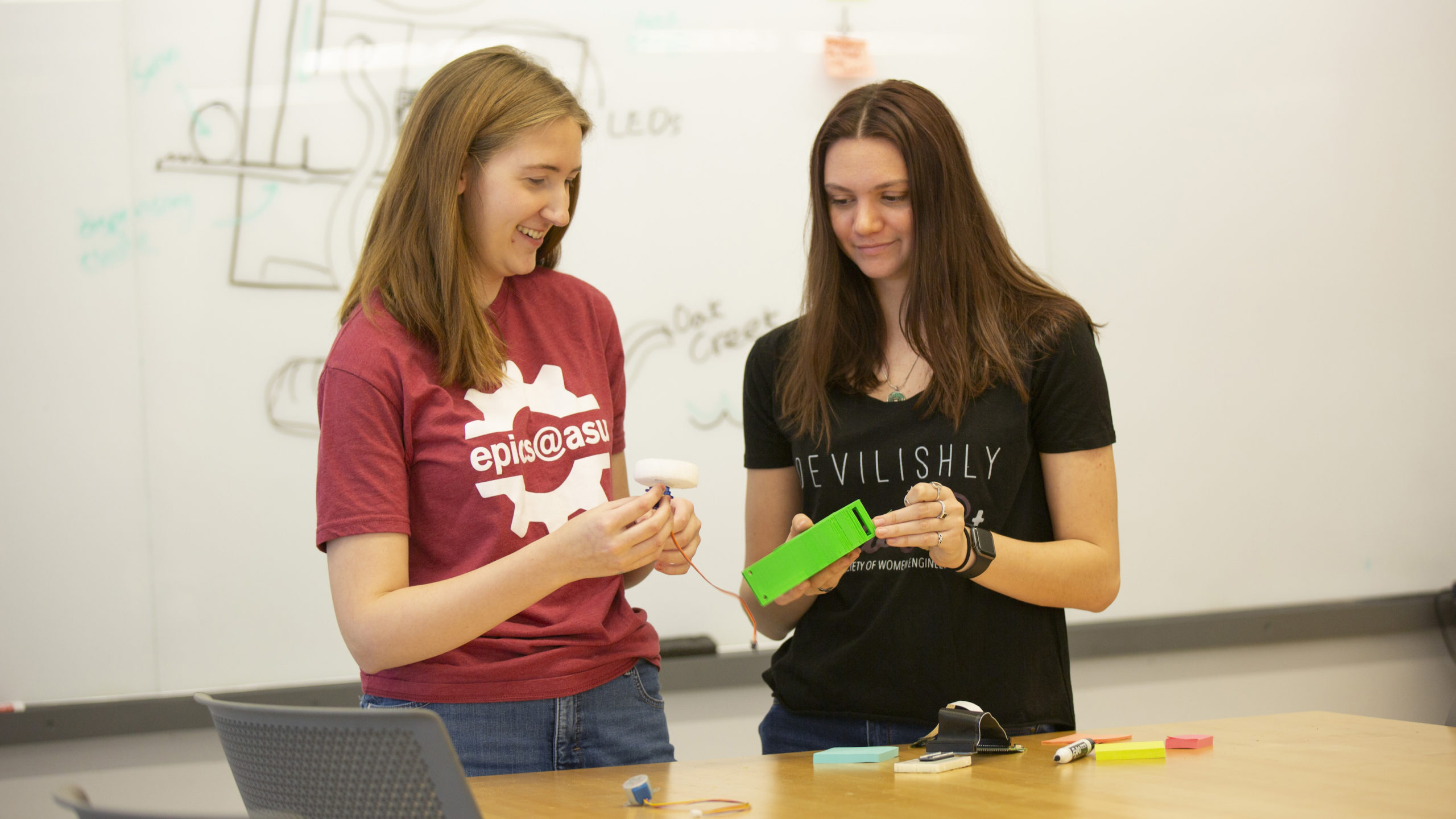
EPICS students look to improve usability of an Arizona treasure

Above: Julie Larsen (left) and Arianna Comes (right) are working to develop a faster autonomous alert system for E. coli measurements in the Oak Creek Watershed in Northern Arizona. The project is a part of the Fulton Schools Engineering Projects in Community Service program, known as EPICS. Photographer: Erika Gronek/ASU
Northern Arizona’s Oak Creek Watershed, near Sedona, is a popular destination for horseback riding, camping, hiking, swimming and other outdoor pursuits. But that popularity comes at a cost.
The water quality at Slide Rock State Park, located within the watershed, suffers from E. coli contamination. With a desire to provide the most up-to-date information on water conditions to the public, two first-year students in the Ira A. Fulton Schools of Engineering at Arizona State University are working to speed up the water-testing process.
An EPICS solution
Arianna Comes and Julie Larsen started a project as seniors at Red Mountain High School in Mesa, Arizona, as part of an Engineering Design and Development course.
“In my junior year of high school, my environmental science class went on a trip to Slide Rock State Park,” says Larsen. “The staff at Slide Rock showed us their lab and explained their procedure for testing E. coli and how it took up to 24 hours to collect results.”
Between 1996 and 2000, a total of 4,177 water samples were collected at five sites in the park and tested for the Escherichia coli bacteria, or E. coli, which stems from fecal pollution via the water and sediment. Of those samples, 75 exceeded the E. coli standard of acceptable levels.
The Oak Creek Watershed Council has led efforts to reduce the pollution by providing pet waste stations and restrooms, as well as leading education outreach to inform Sedona residents of the issue. These initiatives have been successful to an extent, but the E. coli levels remain an issue.
Most of the fecal pollution comes from the natural animal populations in the area. And, storm water runoff, especially during summer months, increases fecal pollution in the water and the sediment.
The current method for testing E. coli at Oak Creek Watershed requires 18 hours of incubation. However, this approach yields results that are not indicative of the present conditions of the water quality in the park.
As Larsen was looking for a project during her senior year of high school, she kept thinking back to her trip to Slide Rock and what she’d learned about the polluted water. So she and her classmate Comes decided to pursue the project.
“Slide Rock is a gorgeous area and loved by so many,” says Larsen. “We wanted to improve the park however we could.”
They decided to develop a faster autonomous alert system for E. coli measurements. The system would inform people when E. coli levels in Oak Creek water exceed U.S. Environmental Protection Agency criteria by posting results on a publicly accessible website.
The pair received funding for their high school project through the Fulton Schools Engineering Projects in Community Service program, known as EPICS. Comes and Larsen competed in the EPICS High competition in which they placed first while at Red Mountain High School.
Comes, now a chemical engineering major, and Larsen, an aerospace engineering major, then decided to attend Arizona State University to study engineering and continue their project at the university level.
The EPICS program provides students the knowledge, funding and opportunity to work on real projects with actual clients who are facing social or environmental problems. Through these projects, students gain real-world experience and acquire skills that are highly valued in the job market.
Elevating the project to the next level
Larsen and Comes investigated a few different methods currently in use. The first method they examined was water turbidity, or water cloudiness.
“There have been research papers that found a correlation between E. coli count and turbidity, but we decided against it, as it wasn’t a high enough correlation (~70%) and the turbidity reading could be affected by outside factors such as animals, weather or visitors,” explains Larsen.
They also considered fluorescence spectroscopy, which measures the amount of E. coli by using a beam of light, usually ultraviolet light, to measure the concentration of E. coli. This method is more accurate, but the cost of sensors was beyond the allotted budget for the project.
The third method they looked into is called the dip test method, which Larsen learned of from a research study conducted at University of Waterloo in Canada in 2018.
“The research study details the procedure to create the test, so we will be replicating it using their procedure in the lab,” says Larsen.
The dip test system functions by submerging a paper-based litmus E. coli test strip into an enclosed container of water pumped from the creek. Within 90 minutes, the color sensor reads the color value to determine the E. coli concentration. The readings can then be transmitted to a website to inform park staff and the general public of the E. coli levels, allowing visitors and park officials to make better decisions about the watershed’s safety.
Currently, the pair is going through all the required lab trainings before they can begin.
“Once we get in the lab, we are going to use the procedure from University of Waterloo to create and test the dip test in a lab setting,” says Larsen.
The EPICS team will be working with graduate students in the lab of Morteza Abbaszadegan, a Fulton Schools professor of environmental microbiology and engineering.
“Dr. Abbaszadegan has done research on detection of E. coli in drinking water, so we are very excited to work with him,” says Larsen.
As first-year students, the two friends are just getting started in the Fulton Schools, and enjoying the opportunity to combine their varied engineering interests in a way that will help make their home state a better place.
“It’s exciting to think of the impact this project can have on the Oak Creek community once it’s implemented,” says Larsen. “The watershed is enjoyed by so many tourists and locals, we are very excited to see how this project can serve the community.”



































